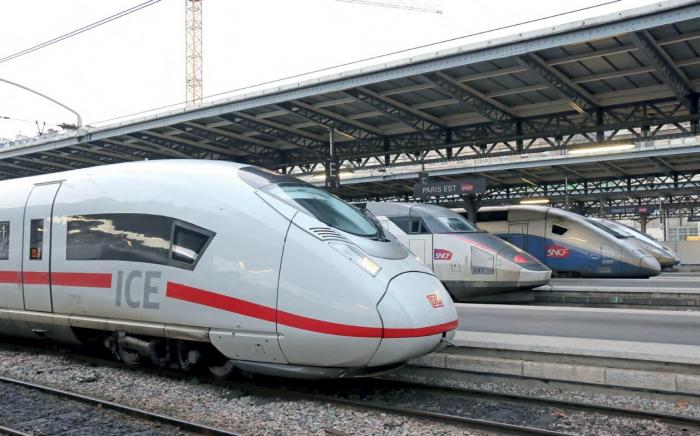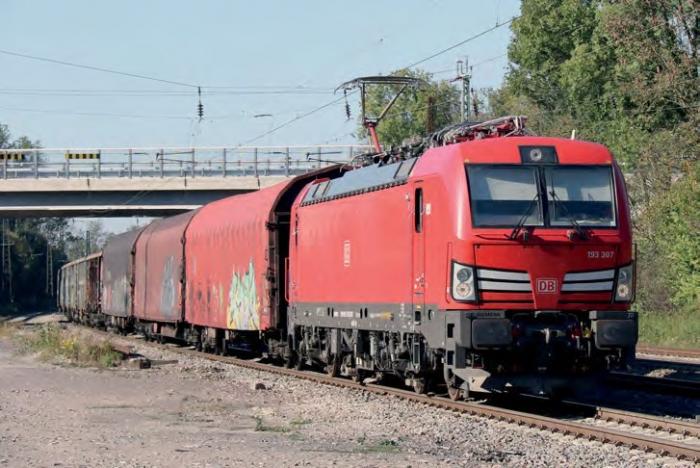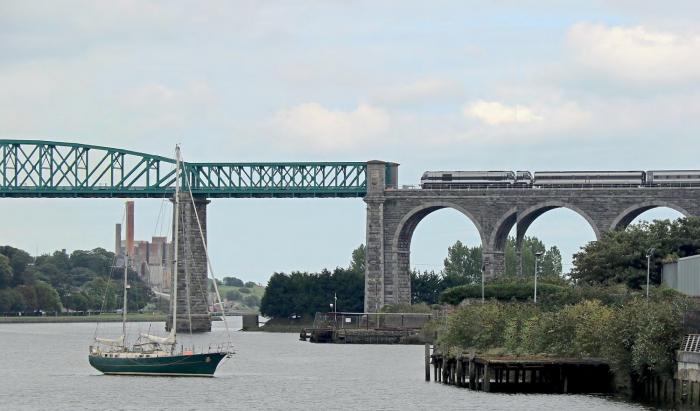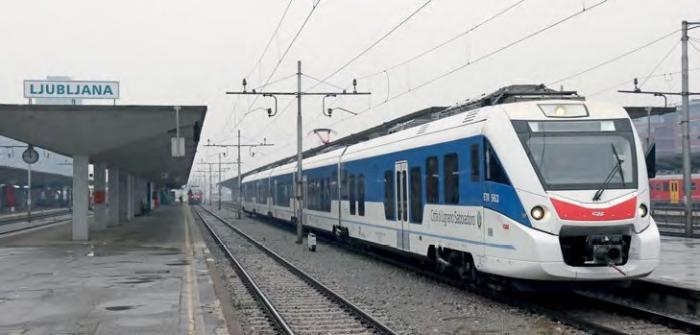
Keith Fender

EUROPE

SIEMENS ALSTOM MERGER BLOCKED BY EU
The European Commission announced in early February that it will not permit the proposed merger of Siemens and Alstom, which originally had been targeted to be complete by the end of 2018. The competition review of the deal by the EU began in July 2018 due to concerns the new merged company would lead to higher prices for rolling stock (and therefore passengers), the number of suppliers in the market would be restricted and that the new merged Siemens Alstom would be three times bigger than its next biggest European rival (Bombardier).
The planned merger of Alstom with Siemens’ transport businesses was first announced by the companies in September 2017, and it initially appeared a full review of the deal by the EU was unlikely as both the French and German governments supported the plan strongly. Trade unions representing workers at the two firms had different views; in France unions objected to the plan whereas in Germany the deal was broadly supported.
Alstom and Siemens and the French and German governments argued the deal would create a European company – dubbed ‘the Airbus of rail’. This would have been able to compete with the world’s biggest rail rolling stock manufacturer, Chinese conglomerate CRRC, which has recently announced plans to offset slowing domestic demand by increasing exports worldwide.
Much of that growth is likely to be targeted in Europe, where CRRC has already had some success selling locomotives in both Serbia and Germany, plus rolling stock in the Czech Republic, Macedonia and the UK. CRRC’s scope for growth in the USA, where it has set up two assembly plants for metro (subway) EMUs following big orders, appears to be limited by the ongoing trade disputes between the American and Chinese governments, which have led to calls to ensure CRRC does not obtain any further federally funded contracts.
Multiple European governments (including UK, Netherlands, Spain and Belgium) objected to the proposed deal on the basis it would reduce competition for equipment, servicing and signalling systems in their countries, as Siemens and Alstom between them account for much of the market already; further afield the Australian authorities raised similar concerns. Other European competitors were also alarmed at the prospect of an already limited number of signalling equipment suppliers becoming smaller; Stadler responded to the proposed merger by setting up its own signalling equipment business able to supply European Train Control System (ETCS) and conventional signalling.
Siemens and Alstom had offered the EU some concessions to get the deal done. This included selling some activities and licensing others, such as the as yet unsold Siemens Velaro Novo very highspeed design, to competitors for up to a decade, but this was not considered enough by the EU competition authorities to mitigate the perceived potential negative consequences of the deal.
Following the rejection of the deal by the commission, there have been calls from politicians in both France and Germany for the EU to rethink its approach to competition law to facilitate the creation of European ‘champions’ in key industries, with the French government being openly critical of the decision.
In preparation for the merger the French state gave up its previous ‘strategic shareholding’ in Alstom; in October 2017 the French government returned the 20% of Alstom’s shares it had held on loan from conglomerate Bouygues and announced it would not take up previous options to buy them. This resulted in Bouygues holding around 28% of Alstom’s shares. The history of this shareholding is complex; in 2014, as part of the sale to GE of the power generation business of Alstom, the French government took the 20% ‘strategic’ stake in the company. This was initially via a loan of shares held by then majority shareholder Bouygues (much of which was held by Bouygues due to the purchase of 21.3% of Alstom’s shares from the Government in 2006 following Nicolas Sarkozy’s €2.5 billion rescue of Alstom in 2004!).
In February Bouygues made it clear following the EU decision that it remains supportive of Alstom and its current market strategy. Siemens had restructured and ‘carved out’ its transport sector or mobility business as a separate company in preparation for the planned deal, and press reports in Germany suggest the mobility company may now be sold by Siemens via a stock market flotation.
ESTONIA

OPERAIL REBUILDING FORMER US DIESEL LOCOS
Estonian state-owned rail freight company Operail has rebuilt several GE C30-7Ai locos in conjunction with Czech company CZ Loko, which specialises in rebuilding old diesel locos (although primarily old Czechoslovak designs). The first three of the modernised C30-M locos were rebuilt for Operail’s own use at its works in Tapa, Estonia in late 2018 and more will follow, with Operail also making them available for lease. In late January the first leasing deal was announced, with two C30-M locos being leased to Ukrainian mining and metal manufacturing firm SCM Group.
The modernised locos – designated C30-M, feature a 1.55MW Caterpillar 3512C HD diesel engine and have a 23-tonne axle loading. They look similar to CZ Loko rebuilt Czechoslovak ChME3 (Czech Class 770) designs, with a new driving cab part way along a low loco body. The original loco frames and bogies are retained in the rebuild process.
Operail, which until mid-2018 was known as EVR Cargo, inherited the former US Class 1 operated diesel locos from former private operator Eesti Raudtee (part-owned by Baltic Rail Services, in turn owned by investors including American firms Rail World and Railroad Development Corporation plus UK-based investors including Jarvis from 2001 onwards). Eesti Raudtee imported a fleet of 58 GE-built C36-7 ex-Union Pacific locos plus 19 ex-Conrail (and CSX/Norfolk Southern) C30-7Ai locos. All were refurbished and re-gauged to 1,520mm prior to entering service in Estonia, where they replaced older Soviet-built designs in 2002-03. Following changes to railway law in Estonia (in part to meet EU directives), Baltic Rail Services sold its shares back to the Estonian Government in 2007. Most of the C36-7 locos remain in service with Operail for heavy freight traffic, whereas the C30-7Ai locos, now being rebuilt, were mostly stored out of use within a few years of arriving in Estonia.
FRANCE

NANCY TO BUILD TRAMWAY TO REPLACE TVR
The eastern French city of Nancy has decided to replace its unique Bombardier-made bi-mode semi-guided trolleybus/bus hybrid TVR (Transport sur voie Réservée) system with a conventional light rail route. The only other French city to previously use the TVR system, Caen in Normandy, decided in 2011 to replace its system with a new conventional tramway that should open in September. The TVR system is effectively a hybrid between electric trolleybus and diesel-powered bus, but with guidance via a single central rail when operating from overhead power supply (about 60% of the Nancy network); elsewhere it operates as an unguided diesel-electric bendy bus with separate bus lanes.
The Nancy TVR system opened in 2000, partly replacing a previous conventional trolleybus network that had been in use since the early 1980s. Plans for up to three TVR lines were not realised as the system was not reliable, leading to planners thinking again about a classic tram-based light rail system as widely used now in French cities. In mid-December 2018 the local authorities approved plans for a new light rail system to replace the TVR system, with a 15km line including 27 tram stops planned. This will be built in three phases at a cost of €412 million; the TVR system will cease operation in 2020/21 to enable the conversion work, and the first new trams should enter service in 2023 with the entire route completed by 2028. Nancy historically had a tram network, but this was closed in 1958.
In late 2018 Keolis was awarded the €346.8 million six-year contract to operate the current TVR system, the bus network and in future the new tramway in Nancy. Keolis intends to improve the reliability of the city’s three new Bus Rapid Transit routes with short-term enhancements to the TVR service from September, although these will not be long-term as the system will close for construction of the new tramway.
GERMANY

DB ORDERS VECTRONS
German national operator Deutsche Bahn has ordered another 40 Class 193 Vectron multi-system electric locos from Siemens for delivery between February and June 2020. DB has signed a new framework contract for up to 100 locos; the first loco was delivered in early February thanks to Siemens’ policy of building some speculative Vectron locos, enabling very fast delivery of new orders. This second DB contract is in addition to one signed in 2017, also for up to 100 locos (60 of which have been ordered and delivered). All the Class 193 locos are for use by DB rail freight subsidiary DB Cargo and will be used to operate international cross-border services; the first batch is in use on the route between Rotterdam and Switzerland using the Betuweroute in the Netherlands.


ODEG WINS MAJOR BERLIN AREA CONTRACTS
DB and private operator ODEG have shared four contracts for major routes serving Berlin and Brandenburg from December 2022 to 2034. ODEG is 50% owned by Trenitalia and 50% by BeNEX (which is in turn split 51%/49% between Hamburg metro operator Hamburg Hochbahn and UK-based investor International Public Partnerships).
Whilst both operators already had contracts for some of the routes, ODEG has increased significantly the number of routes and crucially (as payment is based on this) the number of train kilometres operated, at DB’s expense. The group of services on offer in the Elbe-Spree tender represented 28 million train kilometres annually and was tendered in four lots, with no single bidder permitted to win all the lots on offer.
ODEG won the Lot 1 contract for Magdeburg/ Brandenburg – Frankfurt/Oder ‘RE1’ route services, representing 6.4 million train kilometres a year. This route, which will be increased from two to three trains per hour, was by far the biggest single contract and is currently operated by DB Regio ODEG also won Lot 4, including four shorter regional routes and the new RE8 route, which will be operated as two sections connecting towns on the Baltic coast with others south of Berlin. ODEG already operates part of these routes.
Keith Fender

ODEG also won Lot 4, including four shorter regional routes and the new RE8 route, which will be operated as two sections connecting towns on the Baltic coast with others south of Berlin. ODEG already operates part of these routes.
DB Regio won two lots; the Lot 2 contract totalling 7.3 million train kilometres annually comprises six routes. This includes a new shorter RE2 from Nauen to Cottbus, currently operated (as a much longer route extending north to Wismar on the Baltic) by ODEG, plus five other shorter routes, some of which, including the new ‘Flughafen Express’ (FEX), will serve the new Berlin Brandenburg airport (BER – due to open in late 2020). The Lot 3 contract also won by DB comprises route RE7 (Dessau – Senftenberg via Berlin) plus four shorter regional routes.
ODEG plans to operate the services with a mixture of its existing Class 445 Stadler-built ‘Kiss’ double deck EMUs (which will be refurbished) and new Siemens Desiro HC part double deck EMUs. DB intends to use some existing modern double deck push-pull trains with either Class 182 Eurosprinter locos (as already used for RE1 services) or newer Class 147 Traxx 3 locos transferred from Baden Württemberg. DB is also expected to order new trains.
IRELAND

NO-DEAL BREXIT PLANNING UNDERWAY
The biggest question for the railway companies in both the Republic of Ireland (ROI) and Northern Ireland (NI) is how the withdrawal of the UK from the European Union will affect cross-border rail services. The lack of clarity over whether the border will be a ‘hard’ (with physical border controls) or a ‘soft’ one is not at present assisting with resolution of this question.
Both Iarnród Éireann (IÉ) and Translink NIR are determined that the Dublin to Belfast ‘Enterprise’ services will continue to operate with the minimum of disruption and have established a cross-functional working group, led by the chief executives of both companies, to examine all possible scenarios, including consideration of implications for driver licensing.
Whilst at the time of writing the UK Government has still to reach a conclusion on how Brexit will be taken forward, the ROI has been progressing the primary legislative measures required should there be a ‘no deal’ Brexit (a 95-page draft ‘Omnibus Bill’). The hope is still that a withdrawal agreement between the UK and the EU (including the ROI) can be reached which will maintain the Common Travel Area (the ‘CTA’ – which under various guises has been in place between the ROI and NI since 1923), but being ready for whatever the outcome means the legislation must be ready for implementation by the Irish authorities by the date the UK leaves the EU.
The draft ‘Omnibus Bill’ includes reference to how an agreement can be reached with the UK after Brexit ‘for cross-border rail services’ and the recognition of the certifications of train drivers from non-EU countries. IÉ train drivers were issued with EU driving licences by the Irish Commission for Rail Regulation in November 2018. The Railway Safety Act 2005 will also require amendment to reflect the situation that IÉ staffwill no longer be operating within the EU once north of the border and to regularise how non-EU NIR staffcan operate in the EU while on the IÉ network. In the interim there is a distinct possibility that both NIR and IÉ (and the respective governments) will continue to recognise the licences currently issued to staff, in line with advice already published by the UK government.
The British Government advice on cross-border rail services post-Brexit issued in October 2018 to a large extent mirrors previous advice given by the European Commission to the remaining 27 member states in February 2018. The UK government document says ‘...we would still be able to pursue bilateral agreements with EU countries to maintain cross-border services’; however, the EU guidelines are clear – UK-issued licences for drivers and operators will not be accepted for use in the EU in the event of the ‘no-deal’ scenario.
Whether a bilateral agreement can be settled in time between the UK and ROI governments in the event of ‘no-deal’ is unclear; from the Irish perspective whether such a deal can accommodate/override EU law (which mandates operator and driver licensing) is also unclear! The UK Government has already said the UK will recognise non-UK issued driver licences for two years following the UK leaving the EU under a ‘no-deal’ scenario. Rail vehicles used for cross-border services (passenger and freight) and approved in the EU before the UK leaves will continue to retain approval in the EU and the UK, so all existing rolling stock approved for use in both Northern Ireland and the ROI will remain usable.
Should there be a need for the reintroduction of customs/immigration checks for rail passengers, this may cause major change either to services or how they are operated. The ‘Enterprise’ cross-border service serves Drogheda, Dundalk, Newry and Portadown in addition to Dublin and Belfast, so the governments on either side of the border may introduce controls on identity to confirm immigration status, although as neither country is in the European Schengen area the ‘Lille loophole’ route for non-EU travellers to or from the UK should not be an issue as the existing CTA regulates such travel. Both rail operators wish to avoid anything like the Eurostar Lille experience (for trains from Marseille to London) of passengers having to alight from the train and pass through immigration controls before continuing, with on-train checks between Dundalk and Newry for stopping services a preferred solution. It is clear that a hard border, if this is the outcome, will cost a lot to implement, with infrastructure alterations and higher staff/operating costs.

There is currently no cross-border rail freight, so any in the future would have to take account of whatever the post-Brexit customs arrangements are. IÉ also manages Rosslare Europort, where a specific review of required Brexit-related changes has been undertaken by the Office of Public Works, which co-ordinates controls across all ports. The review looked at likely future requirements for customs, revenue, agriculture and immigration controls as part of the wider Government plans. IÉ is currently reeling from the announcement that Irish Ferries is unlikely to operate from the port to France during 2019 – a surprise announcement as this would be a sea-bridge to Europe for trucks that avoid the UK. Tim Casterton/Keith Fender
NEW SHANNON BRIDGE FOR FOYNES PORT BRANCH
Iarnród Éireann has submitted a planning application with Limerick County Council for the replacement of the Shannon bridge at Churchfield, approximately 2km from Foynes. The current three-span bridge is to be replaced with a new single-span structure with piled abutments and a steel truss superstructure. The redundant intermediate piers will be retained, but in a non-load bearing capacity. The specification is ‘to facilitate the potential future reintroduction of freight traffic on the Limerick to Foynes railway line’. Shannon Foynes Port Company has previously stated it wants the mothballed railway reopened as part of its expansion strategy. Tim Casterton
SLOVENIA


DAILY SERVICES TO ITALY RESTORED
Slovenian Railways (SŽ), in partnership with Italian national operator Trenitalia and the Italian region of Friuli Venezia-Giulia, reintroduced through daytime trains between the Slovenian capital Ljubljana and Trieste in Italy in September 2018. New 3kV DC CAF-built Class ETR563 five-car EMUs, owned by the Friuli Venezia Giulia region and operated by Trenitalia/SŽ, are being used to operate the services, which currently consist of two train pairs daily. Eight ETR563 EMUs from CAF’s Civity family were ordered in 2011, and despite the first train being delivered in 2012 passenger use was delayed for several years. ETR set No 563006 has arrived at Ljubljana from Trieste on 20 December 2018. Four similar dual-voltage units (3kV DC/15kV AC), designated ETR564, have been built for use operating services between Italy and Austria; these have yet to enter service on this route. Keith Fender
LATVIA

TALGO EMU ORDER CHALLENGED
In late November 2018 it was announced that Spanish manufacturer Talgo had won the tender by Latvian national passenger operator Pasažieru vilciens (PV) to supply 32 dual-voltage 3,000V DC/ 25kV AC EMUs and spare parts/stafftraining. The new trains, able to carry up to 450 passengers, will be the first of Talgo’s new articulated regional/ suburban ‘Vittal’ platform to be sold anywhere; unlike Talgo’s better known long-distance trains, the ‘Vittal’ uses conventional two-axle bogies.
Within days two of the unsuccessful bidders, Czech company Škoda Vagonka and Spanish firm CAF, had both publicly objected to the contract award and formally lodged objections with Latvia’s Procurement Monitoring Bureau. The rival bidders told local media their respective bids were lower, based upon the original way they were requested, which differed from the way they had been assessed. Both manufacturers also pointed out they had prior experience of building the trains on offer, whereas Talgo’s train has not been built for any other customer. It is unclear if Stadler, the other unsuccessful bidder, also objected. In late January the Procurement Monitoring Bureau issued a notice prohibiting PV from signing the contract with Talgo until all the other bids had been fully re-evaluated.
PV has announced that Talgo’s offer at €225.3 million was lower than the other bids including spare parts for five years, although the other bidders dispute how this assessment was made, especially as a key component of the assessment was a forecast of whole life costs over 35 years. In November the Latvian government allocated PV up to €259 million for new trains, spare parts and new or modernised depots between 2019 and 2024.
PV intends to use the new EMU fleet (whenever it is actually built) to expand services, including on routes that are due to be electrified at 25kV AC in the next six years. Between 2026 and 2030 the suburban network around Riga, which is currently electrified at 3,000V DC, will be modernised and the voltage changed to the new national standard of 25kV AC. All the pre-existing DC electrification work in Latvia was undertaken prior to the collapse of the Soviet Union, starting in 1966.
The planned procurement of the new PV EMU fleet has been underway for nearly a decade without any firm order being made! In 2011 PV ordered 34x3-car EMUs and 7x3-car DEMUs from CAF; the plan then was that CAF would build the Civity design trains in conjunction with Riga-based train builder Rīgas Vagonbūves Rūpnīca (RVR), which built thousands of EMU and DMU vehicles in Soviet days. The first six EMUs were to be built in Spain and after that production would progressively move to Latvia, with all the new trains in service by 2015. The contract was valued at €400 million, including a 30-year maintenance agreement.
In October 2012 the contract was ruled as having breached Latvian procurement rules after complaints from other bidders and in April 2013 the Latvian Government decided to use the funds set aside for the new trains for other rail investment projects. In April 2014 PV received tenders from Pesa (Poland), Stadler and Hyundai-Rotem from South Korea in response to a new tender for a leased fleet of 25 to 45 EMUs for a 15-year period, with purchase by PV envisaged at the end of the period (assuming it was cost-effective). This tender also ended inconclusively after Hyundai-Rotem withdrew its bid; the government decided the next best offer from Stadler was too expensive and cancelled the project! In the meantime, PV’s passengers continue to use RVR-built EMUs dating from the 1970s/80s; the latest tender began in September 2015.




